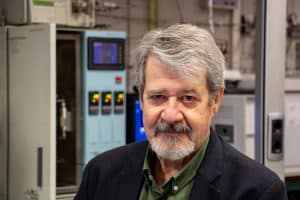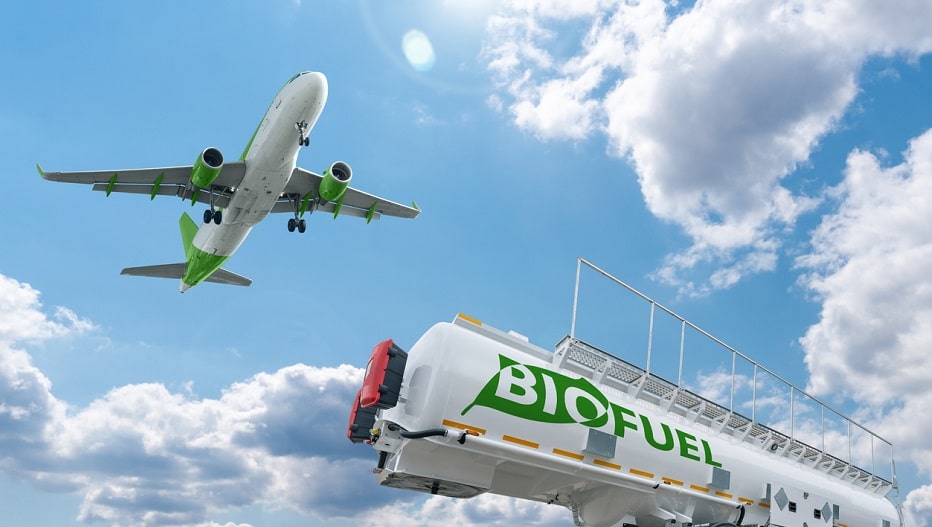Raquel Lopez Ocal | 08/09/2022
Aviation is a key sector of the global economy, but also one of the most stigmatized by its environmental impact. However, its energy efficiency has improved considerably in recent years and its commitment to sustainability is on the rise. Professor José Antonio Odriozola, Professor of Inorganic Chemistry at the University of Seville, tells us about the achievements obtained by the sector and the challenges to be overcome.
The aviation sector has always been identified as a polluting activity, but it has been trying to reduce its environmental impact for decades, mainly through the replacement of fossil fuels. José Antonio Odriozola, Professor of Inorganic Chemistry at the University of Seville, explains that the first advances in research on liquid fuels (BTL – Biomass to Liquids) obtained from biomass were made in Germany a century ago, in the 1920s, but they were quickly abandoned because they did not reach a competitive price for the time. We’ve had to wait for the 21st century to bring their potential to reality.
“In February 2008, Virgin Atlantic took the first test flight between London and Amsterdam with a Boeing 747 powered by fuel that contained 20% of a biofuel sourced from coconut and babassu oils. It is important to note that BTLs must strictly comply with the technical specifications for petroleum-derived fuels and, on that flight, they did not yet comply with current regulations. From that time and up until 2015, tests were carried out involving up to 22 airlines and 2,500 passenger-carrying commercial flights with a wide variety of biofuels from different origins – various types of used cooking oils, Jatropha, Camelina, algae – that do comply with the regulations”, he affirms.
With this gradual move towards the use of biofuels, in 2016 United Airlines became the first company to introduce Sustainable Aviation Fuel (SAF) on its regular routes, becoming a benchmark for 44 other international firms that would start implementing it successfully over the next three years. “All of these biofuels, derived from certified processes, were mixed with conventional fuels with a presence of between 90% and 50%,” Odriozola says. In 2021, passenger-carrying test flights were finally carried out using 100% SAF, and in 2022 companies such as Boeing, ATR and Airbus joined this line.
Driving global engagement
One of the most promising steps towards a sustainable future for the sector was ‘Destination 2050’, a European aviation roadmap to zero emissions. The reduction comes hand-in-hand, the expert explained, with an improvement in engine efficiency, the optimization of operations and logistics, economic measures and, mainly, the use of sustainable fuels, which allow a reduction in CO2 by up to 80%. “Raw materials for production are varied and include animal and vegetable fats, used oils, urban solid waste and crops that have no involvement with human or animal food,” Odriozola says. These fuels are only considered sustainable if their origin does not compete with crops intended for food, does not compete for water sources and does not contribute to deforestation processes.
“There are currently a wide variety of technologies capable of converting biomass into biofuels. The degree of development is also very varied, from commercial processes to others that are still at the research and development phase,” says the professor from the University of Seville. In these technologies the type of raw material (biomass) is decisive.
Biomass-derived oils must be subjected to HEFA – a combination of chemical processes in the presence of high-pressure hydrogen – that allow the removal of oxygen, the branching of molecules and their cracking (shortening to the dimensions required by aviation fuels).
- Catalytic thermolysis (CHJ) performed at high temperatures, over 450°C and high pressures, is a complex process that transforms the triglycerides of vegetable and algae oils to produce the aromatic hydrocarbon molecules required for the formulation of aviation fuels.
- Solid biomass (urban and agricultural solid waste) is converted to fuel through complex processes (FT-SPK) including gasification, catalytic and branched methods, at high pressures and temperatures.
“The most developed and economically viable are those biofuels obtained by the HEFA process, although major efforts are being made to expand the catalog of techniques that will permit the feasibility of the remainder and, in particular, derivatives of the FT-SPK process seem the most promising,” the expert said.
Biojet – the solution and future of the industry
Biomass-derived fuel, also known as Biojet, has a multitude of formulations on the market that have already been implemented by most major airlines. “As I said, most flights have been made with HEFA fuel supplied by companies such as SkyNRG, Neste Oil, or Honeywell,” says Professor Odriozola. In addition to the significant reduction in emissions – which can exceed those of fossil fuels by 90% – Biojet does not contain sulfur, which is responsible for acid rain, while also emitting up to 60% less particulate matter due to its lower concentration of aromatic compounds. “The impact on the environment is indisputable, but it also contributes to the elimination of urban solid waste deposits that produce emissions of methane (an even more powerful greenhouse gas than CO2) and leachables, affecting the subsurface and potentially aquifers,” the expert says, pointing out the synergy that follows with the agricultural sector, thus optimizing waste management by forming “the basis of new industries in the rural sector, generating economic value rather than costs to producers.”
In addition, biofuel use positively impacts many other aspects that relate to the UN Sustainable Development Goals, such as the fact that:
They provide an affordable, non-polluting power source.
- They support the implementation in all territories of new local industries.
- They promote the creation of new jobs and equality-based economic growth.
- It generates a higher quality of life in rural areas.
“In other words, the need to replace conventional fuels from fossil sources with biofuels to curb global warming is, in parallel, a social paradigm shift that should lead us to fairer societies,” he explains.
For José Antonio Odriozola, it is difficult for the sustainability objectives adopted globally by the aviation sector to be met with another type of fuel. “In the longer term we can think of hydrogen-powered aircraft, but there are still great challenges for the implementation of this technology,” he says. On the other hand, electric propulsion is hampered by the high weight associated with batteries, making their use unfeasible. Their energy density is too low, so with current technology the weight required to obtain the same energy density per kilogram of weight makes their use unfeasible. “In summary, with the 2050 horizon ahead of us, there is no alternative to Biojet to meeting the goal of zero greenhouse gas emissions,” he concludes.

Article Collaborator:
José Antonio Odriozola has a degree in Chemistry from the University of Seville, and is a Professor of Inorganic Chemistry at the same university. He has been the coordinator of the Doctorate Program in the Science and Technology of New Materials at the universities of Extremadura and Seville since its creation in 2009, and of the Materials Science and Technology panel of the National Evaluation and Prospecting Agency (now the Spanish Research Agency) from January 2004 to December 2006.
He has been a visiting professor at the Universities of Strasbourg (France), Rennes (France), National Autonomous University of Mexico, Huazhong University of Science and Technology (China) and Beijing Forestry University (China).
He has published more than 400 articles in international scientific journals and three books, has directed 40 doctoral thesis and has filed 13 patents for the University of Seville, Petrobrás (Brazil), Acerinox (Spain) and Cernix (France).
Throughout his career, he has spent years studying energy and environmental-related catalytic processes, particularly the synthesis of new fuels and high-value-added products from residual biomass.





